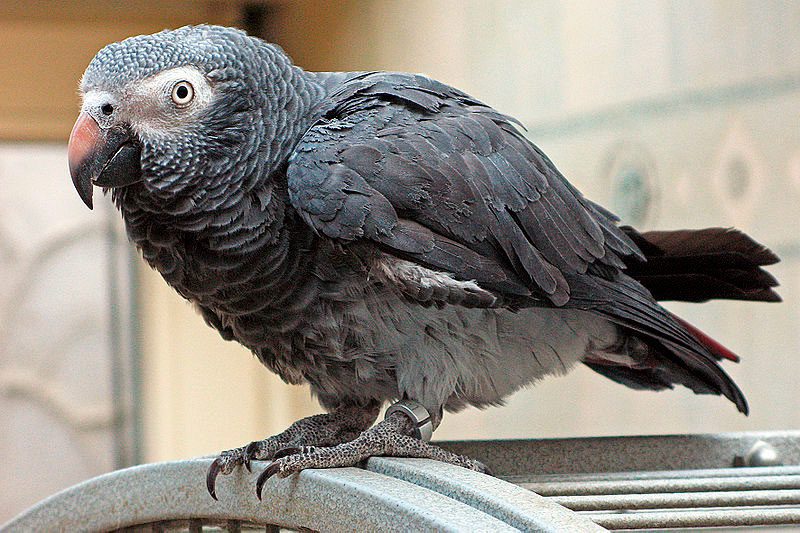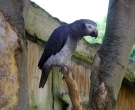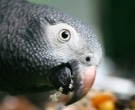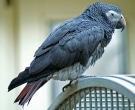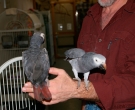Content
|
|---|
Description:
28 to 32 cm.. length and a weight between 275 and 375 g..
The Timneh Parrot (Psittacus timneh) is darker than Grey Parrot and the Red of the the tail feathers more off, darker and usually Brown (not Scarlet).
The uppertail-coverts son grises, dyed red (not Scarlet).
The bill It is mostly black, but it has an ivory-coloured or pinkish in the upper third of the upper jaw.
There is no visible difference between male and female.
The youth they have black eyes that become a yellowish cream at the age of two years.
Smaller that the Grey Parrot
- Sound of the Timneh Parrot.
Description 2 subspecies:
-
(Alexander, 1909) – Darker and slightly larger than the subspecies Psittacus timneh timneh, although its size is still below the Grey Parrot (Psittacus erithacus). The feathers of the tail are as red as those of Grey Parrot, but marked by a greater contrast with the almost black feathers body, giving a different impression this subspecies. The eyes are yellow, the bill It is black and legs are dark gray.
Psittacus timneh princeps
-
(Fraser, 1844) – Nominal.
Psittacus timneh timneh
Habitat:
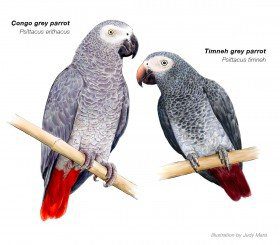
Although they normally inhabit the dense forests, they are also usually seen at the edges of forests, clear, gallery forest, mangroves, tree-lined sheets, cultivated areas, and even the gardens, Although it is not clear if it's self-sustaining populations.
You can do seasonal movements out of the drier areas of its distribution in the station area dry.
Sometimes travel long distances to feed. They nest in hollow trees high above the ground. Found in small flocks of a few dozen, usually no more. Flocks of birds can be noisy.
Reproduction:
Little known difference with regard to the Grey Parrot.
The breeding season is usually from November to April in the westernmost areas of west africal, probably, especially during the season dry.
During the season of breeding they put in 2 to 4 eggs, every two or three days. These hatch in 28-30 days and the young are independent in 12 to 14 weeks.
Food:
In the wild, the Timneh Parrot they eat seeds, nuts, fruits and vegetables. they climb trees, instead of flying, to collect food and keep it with one leg while eating. They enjoy eating the external Walnut meat of the Palm oil, and have been observed eating snails.
In West Africa, his hobby is known for beads, attacking cornfields and becoming considered pests in certain places.
Distribution:
Size of the area of distribution (reproduction / resident): 541.000 km2
They are distributed in the West, in the humid forest areas of the Upper Guinea and bordering savannahs of West Africa from Guinea-Bissau, Sierra Leone and South of Mali to the East of Ivory Coast, at least a 70 kilometers to the East of the bandama river.
The wild population is distributed along with the species nominal in Abidjan, Ivory Coast.
Distribution 2 subspecies:
-
(Alexander, 1909) – Principe Island (gulf of guinea).
Psittacus timneh princeps
-
(Fraser, 1844) – Nominal. South of Guinea, Sierra Leone and Liberia, as well as the western part of Ivory Coast. There are also smaller groups Guinea Bissau and Mali. Populations Senegal They have disappeared fish trade.
Psittacus timneh timneh
Conservation:
• Current Red List of UICN: Vulnerable
• Population trend: Decreasing
Its population is estimated between 100,000 and 500,000 exemplary and decreasing.
The P. erithacus, before the division of the timneh, He was put in the Appendix II of CITES with all Psittaciformes in 1981 at the request of Switzerland and Liechtenstein. Due to concerns about the effects of the large number of this species traded, It was the subject of a review of significant trade of the CITES, in which was listed as “possible concern” (Inskipp et to the. 1988).
The Animals Committee of the CITES he imposed a sanction of two years from January of 2007 on exports of timneh from four countries of West Africa (Ivory Coast, Liberia, Sierra Leone and Guinea), and banned the import of wild birds into the EU in 2007 (Anon 2011).
In 2009 Guinea exported 720 timneh, Despite having a share of 0 (Anonymous 2011).
The controlled legal trade by CITES may represent only a small proportion of total numbers caught in the wild.
The species is found in a number of protected areas.
A PhD study assessed the distribution, abundance and the impacts of trade and habitat loss for the timneh started in 2011 (Anon 2011).
Conservation Actions Proposed:
-
• Ensure that proposed trade restrictions are enforced.
• Monitor wild populations to determine ongoing trends..
"Timneh Parrot" in captivity:
Poultry are known in a manner abbreviated as TAG (Timneh African grey).
The Parrot Timneh is equivalent in intelligence and ability of his Congo counterpart, the Grey Parrot, being, generally, less nervous and with a great ability to imitate sounds (they often learn to imitate human sounds before the Grey Parrot). They can have a wide vocabulary of hundreds of words.
Unlike the Parrot Yaco, their voices are not an exact replica of the voice of the person you are copying. The Timneh Parrot they have their own special little voice.
Alternative names:
– Timneh Parrot, Gray Parrot (Timneh), Sierra Leone Gray Parrot, Sierra Leone Grey Parrot, Zambesi Green Pigeon (English).
– Perroquet timneh (French).
– Timnehgraupapagei (German).
– papagaio-timneh (Portuguese).
– Loro timneh, Loro Gris de Cola Vinagre (español).
scientific classification:
– Order: Psittaciformes
– Family: Psittacidae
– Genus: Psittacus
– Scientific name: Psittacus timneh
– Citation: Fraser, 1844
– Protonimo: Psittacus Timneh
Images “Timneh Parrot”:
————————————————————————————————
“Timneh Parrot” (Psittacus timneh)
Sources:
– Avibase
– Parrots of the World – Forshaw Joseph M
– Parrots A Guide to the Parrots of the World – Tony Juniper & Mike Parr
– Birdlife
– Photos:
(1) – Timneh African Grey Parrot (Psittacus erithacus timneh) Pet parrot sanding on a cage By Peter Fuchs (Flickr) [CC BY-SA 2.0], via Wikimedia Commons
(2) – Two pet Timneh African Grey Parrots perching on a man’s arm By rebeccakoconnor (originally posted to Flickr as Timneh Greys) [CC BY 2.0], via Wikimedia Commons
(3) – Timneh African Grey Parrot (Psittacus erithacus timneh). A pet parrot standing on a cage. Photo shows the maroon tail feathers By Peter Fuchs (originally posted to Flickr as henry tired) [CC BY-SA 2.0], via Wikimedia Commons
(4) – A Timneh African Grey Parrot at Birds of Eden, South Africa By Graham (originally posted to Flickr as IMG_0972) [CC BY-SA 2.0], via Wikimedia Commons
(5) – A Timneh African Grey Parrot that is allowed to fly free in Tropical Birdland, Leicestershire, England I, Snowmanradio [GFDL or CC-BY-SA-3.0], via Wikimedia Commons
(6) Ilustración by Judy Maré – Africa Geographic Magazine
– Sounds: Etienne Leroy (Xeno-canto)
